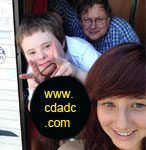

Obesity and Down’s Syndrome
Chronic obesity is one of the more serious long-term health problems that often affects people with Down’s Syndrome.
There are a lot of reasons to believe that this tendency towards obesity begins early on in life.
However, because of how children in general and children with Down’s Syndrome in particular work, dieting is generally not a good idea.
While exercise is better, it must often be done relatively carefully.
Understanding the causes of and best ways to prevent obesity in children with Down’s Syndrome is a high priority for any caregiver or parent.
Possible Causes and Current Research into Obesity and Down Syndrome
We know that obesity does not happen in children with Down’s Syndrome for the usual reasons.
Normally, if someone eats too many calories and does too little exercise, obesity is sure to follow.
However, in every study of the diets of children with Down’s Syndrome compared to their peers, they often ate fewer calories and did just as much physical activity.
Obesity does not come about in people with Down’s Syndrome for the same reasons as everybody else.
While the exact cause is not yet known, there are a few things that seem to contribute mightily.
Children with Down’s Syndrome often have problems with hypotonia, which can lead to decreased activity. Because children with hypotonia often learn gross motor skills later than other children, they aren’t always as active in the early years.
In fact, hypotonia-related inactivity can start a vicious cycle. The child can’t play or exercise because of hypotonia, the child doesn’t get enough activity, the child starts getting obese and then gets even less activity due to the double effect of obesity and hypotonia.
Another problem that children with Down’s Syndrome often have is stunted growth.
They often don’t get as tall as their age mates, both in the early phase of growth in the first two years after birth and in the growth spurt accompanying puberty. Well, if they’re taking in enough food to get the nutrients they need, they’re also taking in enough calories to grow as tall as they would without the genetic problem. All that energy has to go somewhere, and it usually winds up in fat stores.
Institutionalization seems to be another underlying cause of obesity in children with Down’s Syndrome, although the whys and wherefores aren’t entirely clear.
What we know is that kids with Down’s Syndrome have a greater tendency towards obesity when they’re in institutions than when they’re raised at home.
Theories on why include a lack of stimulation recieved in an institution, a lack of motivation to play on the part of the child, and an overall lifestyle that doesn’t ask the child to do much on an everyday basis.
These theories are currently being tested, and nothing’s sure yet. However, we do know that children with Down’s Syndrome generally do better when living at home in a supportive family environment.
Another reason that people with Down’s Syndrome may suffer from obesity is the metabolic disorders they are unfortunately prone to.
Many children with Down’s Syndrome either already have or will develop diabetes mellitus Type 1 or Type 2 at some point in life. Diabetes itself is known to contribute heavily to the risks of obesity.
Insulin resistance is a condition wherein the body is producing insulin, it’s just not responding to it properly. It’s often seen as a precursor to diabetes Type II, and can often increase the risks of obesity by itself.
In addition to diabetes, children with Down’s Syndrome are at risk for other metabolic diseases of one sort or another. One of the most preventable is hypothyroidism, and thyroid tests should be the first thing looked at if obesity starts to become a problem.
Researchers recently found that children with Down’s Syndrome had significantly higher levels ofleptin in their bodies than their genetically normal siblings.
Leptin is a hormone produced by the body that’s supposed to suppress appetite and regulate body weight. The higher levels of this hormone found in children with Down’s Syndrome may indicate a level of leptin resistance.
Like insulin resistance, leptin resistance is a problem where the body produces more than enough of the hormone, but the rest of the body isn’t listening to it very well. The sample size on this particular study was a bit limited, so this theory isn’t considered proven just yet. However, it’s giving researchers new places to look.
Yet another theory that’s currently in testing phase is the idea that people with Down’s Syndrome have a lower resting metabolic rate than people without.
If this is true, then the metabolic rate for people with Down’s Syndrome would be down across the board no matter what level of exercise they’re doing.
They’d also get fatigued more quickly, which may lead to them quitting exercises before they can get any real, long-term benefit out of them.
What we do know is that the people with Down’s Syndrome who have the least risk of obesity are relatively tall, have good muscle tone, and live at home with good preventative medical care.
The people at most risk for obesity are relatively short, somewhat hypotonic, and live in an institution with a minimum of even conventional medical care.
Progression of Obesity in those with Down Syndrome
What we do know is that problems with obesity can start incredibly early for children with Down’s Syndrome.
One study showed that 22% of the children with Down’s Syndrome studied were considered overweight in their first year of life.
55% of this study group became overweight between their first and second birthday, and 23% were classified as overweight in their third year.
Another study found an increased risk of obesity in children with Down’s Syndrome between 25 and 48 months old.
Adolescence is another risky time, with a huge number of children with Down’s Syndrome becoming obese right along with all the other body changes of puberty.
Certainly, if you start seeing those typical cellulite bumps, you know they have likely crossed the line to being overweight.
What Can We Do about obesity in those with Down Syndrome?
The best thing we can do for our kids is to start early and prevent obesity.
It’s always easier to prevent it than it is to peel off the extra pounds once they’re there, and that goes double for people with Down’s Syndrome because their obesity problems aren’t related to their diet.
One thing that parents and caregivers should not do is put their children on diets, unless they are eating unhealthy high calorie foods and drinks. www.WeightLossHelpFast.com has alot of information about eating healthy and many low calorie recipes and a free weight lost program.
Children need the fat and cholesterol of a normal, healthy diet in order to grow and develop properly.
It would be very difficult for a child to get all the vitamins, minerals, proteins and fats he or she needs from a weight-loss diet. That doesn’t mean that your child should have junk food any more than any other child, but never deny nutritious food because it’s too high in fat or carbohydrates.
In addition, you don’t have to deny occasional treats to your child. One candy bar a month is not going to make much of a difference.
Now, there are only two ways to prevent or solve obesity, and those are to eat less and exercise more.
In the case of children, more exercise is the best way to go.
In a way, exercise offers your child a double benefit.
It’s both the most effective tactic in and of itself against obesity, and over time it will increase your child’s base metabolic rate.
If the base metabolic rate increases, your child will be burning more calories even while sleeping.
The activities you can do with your children is limited only by your imagination.
It’s best if you can work higher levels of activity into their every day lives instead of trying to get them to “exercise” per se.
If they have to do exercise itself, they may come to regard it as a hated chore they’ll skip if they can get away with it. Considering that the goal is to help them develop a lifelong habit, that’s not a good idea. Instead, try to think of family activities that will be fun for your child.
A range of possibilities include:
Walk or bike to nearby destinations on a regular basis. This can be to rent movies, get a treat, or whatever you can dream up to make it fun.
If your child has problems walking long distances, bring an appropriate wheeled conveyance or be prepared to take a number of breaks.
Go swimming at local pools.
Park out in the outer ring of spaces at stores, requiring a further walk to the entrance.
Schedule a walk for fun on a daily basis. Especially good if you have a dog.
Play running games with your child at parks. Possibilities include tag, baseball for fun (i.e. make up the rules to be suitable) tag hide and go seek, the possibilities are endless.
Assign safe lawn chores such as mowing with a push mower, raking leaves or clearing driveways. Adjust to age, of course.
Remember to allow for any physical disabilities your child may have.
If his or her hip hurts, walking isn’t going to be very much fun. In addition, if your child has heart problems it’s important to run the details of any exercise plan past your child’s cardiologist before beginning.
Conclusion on Down Syndrome and Obesity
While we may not be able to do much for every child who suffers obesity from Down’s Syndrome, by working with what we already know we can prevent it in a huge number of our children.
Prevention begins with education.
New research is coming out all the time that will help us to continually improve both length and quality of life for our children.
By making physical activity fun and carefully monitoring for metabolic problems, you can help your child live a longer, happier life.
Research and Main write by Loni Ice, minor editing by Donald Urquhart

Leave a Reply
You must be logged in to post a comment.